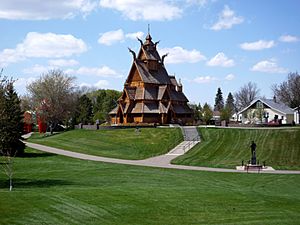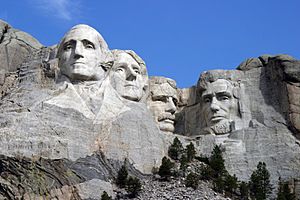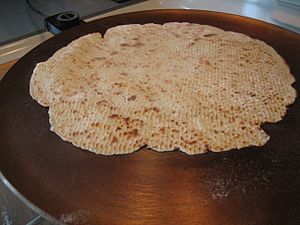Norwegian Dakotan facts for kids
| Total population | |
|---|---|
| 312,697 21.4% of the Dakotan population |
|
| Regions with significant populations | |
| 199,154'''' | |
| Fargo | 37,343 |
| Grand Forks | 17,438 |
| Bismarck | 13,095 |
| Minot | 10,945 |
| West Fargo | 8,839 |
| 113,543'''' | |
| Sioux Falls | 26,630 |
| Rapid | 7,584 |
| Watertown | 4,137 |
| Brookings | 4,082 |
| Aberdeen | 3,809 |
| Languages | |
| American English, Norwegian | |
| Religion | |
| Lutheran Christianity | |
| Related ethnic groups | |
| Norwegian American | |


A Norwegian Dakotan is a person living in the U.S. states of North Dakota or South Dakota who has family roots from Norway. About one in three people in North Dakota have Norwegian heritage. This is the highest percentage of Norwegian Americans in any U.S. state! South Dakota is also high on the list, coming in third after Minnesota. Most Norwegian immigrants settled in these states between 1870 and 1920.
As of 2009, over 312,000 people in the Dakotas said they had Norwegian family roots. This means about 21.4% of the region's population has Norwegian heritage. In North Dakota, it's 30.8%, and in South Dakota, it's 14.0%.
Contents
History of Norwegian Settlements
Early Arrivals
The first Norwegians arrived in the Dakotas as early as 1859. This was shortly after a special agreement was signed with the Yankton Sioux tribe. However, it took another ten years for many more Norwegians to start moving there.
North Dakota Settlements
Norwegian immigrants began arriving in North Dakota in the 1870s. They mostly settled in the eastern and northern parts of the state. Today, you can find people with Norwegian heritage all over North Dakota. Many came because there wasn't enough good farmland in Norway. They heard about the amazing, fertile land in North Dakota. Some immigrants even lived in other states for a few years before finally settling in North Dakota. In 1880, about 8,814 Norwegians lived in North Dakota. By 1900, that number had grown to 73,744!
Some towns like Columbus and Larson were founded by Norwegian settlers. For a long time, almost everyone in these towns had Norwegian roots. However, like many rural areas, these towns have become smaller over time. Even though they have strong Norwegian heritage, people there mostly speak English now. There are even some ghost towns in North Dakota that were once Norwegian settlements.
Settlers from Telemark
Many settlers from a region in Norway called Telemark moved to North Dakota in the late 1870s and early 1880s. For example, a group from Telemark settled near what is now Bue in Nelson County in 1880. They grew wheat and raised cattle. They would sell their crops and animals in towns like Valley City and Grand Forks.
A famous person from Telemark, Sondre Norheim, known as the "Father of Modern Skiing," also moved to North Dakota. He left Norway in 1884 with some of his children. After living in Minnesota for a short time, they moved to North Dakota, near Villard. Even though the flat land of North Dakota wasn't great for downhill skiing, he always kept a pair of skis by his door! Sondre Norheim became more religious as he got older and helped build a Lutheran church in Villard. He passed away in 1897.
South Dakota Settlements
In 1860, only 129 Norwegians lived in South Dakota. But things changed quickly! By 1880, one out of every ten people in South Dakota was Norwegian. By 1889, it was one out of every three! Towns like Roslyn and Pierpont were almost entirely Norwegian when they were first settled.
South Dakota has also had several governors with Norwegian family roots. For example, Niels Boe, the state's third governor, was born in Bergen, Norway, in 1847. He came to Dakota with his parents when he was young. Sigurd Anderson, the 19th governor, was born in Norway in 1904 and settled with his family in Lincoln County, South Dakota, which has many Norwegians. Augustana University in Sioux Falls, a well-known college, was originally a Norwegian Lutheran college in Canton, South Dakota.
Cultural Influence
Norwegian immigrants, along with other people from Scandinavia, played a huge role in shaping the Dakotas. It's rare to see one group influence a place so much, especially a group that wasn't huge to begin with!
Food Traditions

When Norwegians moved to the Dakotas, they brought their delicious food traditions with them. The Dakotas, along with Minnesota, are famous for their Scandinavian dishes. Foods like Lefse (a soft flatbread), Krumkake (a thin, rolled cookie), Lutefisk (a type of fish), and Raspeball (potato dumplings) are popular. These foods are enjoyed not only by Norwegian Americans but by many other people in the states too!
Many churches in the Dakotas host annual dinners where they serve these traditional Norwegian foods. One of the biggest is the annual Lutefisk Dinner at the First Lutheran Church in Williston, North Dakota, every February.
The largest Scandinavian festival in North America is the annual Norsk Høstfest. It happens every October in Minot, North Dakota. This five-day event celebrates Scandinavian culture and features many traditional dishes.
Language Changes
When Norwegians first came to the Dakotas, they all spoke Norwegian. Over time, most of them learned English, and their children grew up speaking English. There used to be many Norwegian-language newspapers in the United States. But after the 1920s, when fewer immigrants arrived, the number of Norwegian speakers went down. This is because younger generations didn't need to learn Norwegian as their main language since everyone spoke English.
However, some Norwegian words and phrases are still used today, even if they don't sound exactly like they would in Norway. A common one is "Uff da!" which is like saying "Oh dear!" or "Darn it!" Today, only a small number of people in North and South Dakota speak Norwegian as their main language, and most of them are older. But many more people understand some basic Norwegian words and phrases.
Some communities in North Dakota still have a higher percentage of Norwegian speakers. For example, Northwood, North Dakota has about 4.41% of its residents speaking Norwegian. Other towns like Mayville, North Dakota and Crosby, North Dakota also have a notable number of Norwegian speakers.
Norwegian Heritage Today
The number of Norwegian Americans in the Dakotas has stayed pretty steady over the years. In 2009, there were over 312,000 Norwegian Dakotans.
North Dakota Heritage
In North Dakota, people with Norwegian heritage tend to be a bit younger than the state's average population. In 2000, about 30% of North Dakota's population, or over 193,000 people, said they had Norwegian family roots. Many people of Norwegian descent, especially older ones, still keep up some traditions that connect them to Norway.
South Dakota Heritage
In South Dakota, about 15% of the population, or over 115,000 people, said they had Norwegian family roots in 2000. The average age of Norwegian South Dakotans is similar to the state's overall average age.
Communities with Strong Norwegian Roots
Many communities in the Dakotas have a very high percentage of people with Norwegian ancestry. For example, Northwood, North Dakota has about 55.5% of its residents claiming Norwegian roots. Other towns like Crosby, North Dakota (52.3%) and Mayville, North Dakota (48.5%) also have strong Norwegian heritage.
Some counties also have a very high percentage of Norwegian ancestry. Divide County, North Dakota leads with about 64.7% of its residents having Norwegian roots. Steele County, North Dakota (62.0%) and Traill County, North Dakota (59.0%) are also very high on the list. These areas show just how much Norwegian culture has shaped the Dakotas.
|

